Build
Your Own Arcade Controls
 Gerald
Gorman's Cabinet
Gerald
Gorman's Cabinet
Gerald from Chile put together
a really very nice arcade cabinet project that he sent me to share with
everyone. Be sure to take a closer look at the arcade graphics on
the cabinet :) Thanks Gerald!

Gerald's quest for a cabinet
started from the moment he first laid eyes on MAME. A day after graduating,
he tracked down an old Tetris cabinet made in Chile. He explained
his project to the guy he bought it from, who didn't believe him... Sound
familiar? The results are slick ... :)
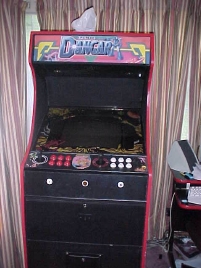

The
Artwork
A friend of Gerald's helped him
with the artwork for the cabinet. The original cabinet was in fairly
bad shape, so Gerald redid the artwork with some custom graphics...

(Click for a larger view) |
The monitor bezel
artwork was made by Gerald,
with the graphics
coming from a very blurry
and small image of
Space Invaders, and a few good
quality flyers for
some old games. It's a bit hard to
see, but that's the
"MAME Video" running on the monitor :) |
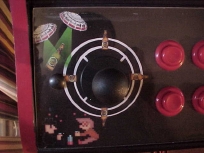
(Click for a larger view) |
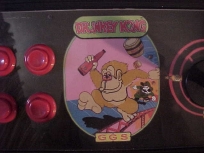
(Click for a larger view) |
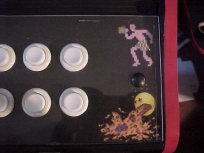
(Click for a larger view) |
|
The control panel
artwork done by Gerald's friend. Take a careful look ... Think his
friend has any particular interests? :)
|
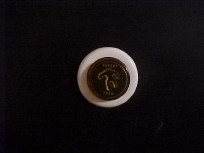
(Click for a larger view) |

(Click for a larger view) |
|
I also like the
artwork on the buttons. Once more, I find something that I want on my cabinet
:)
|

The
Monitor
One of the slicker things about
this project is the rotating monitor - and it's easy as can be to rotate...
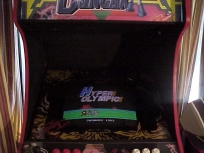
(Click for a larger view) |
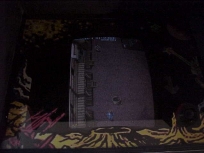
(Click for a larger view) |
|
On the left, you
see Hyper Olympic, a horizontal game playing on the 20" monitor.
On the right is Gunsmoke, played vertically... It took Gerald about 15
seconds to rotate the monitor!
|
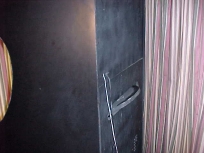
(Click for a larger view) |

(Click for a larger view) |
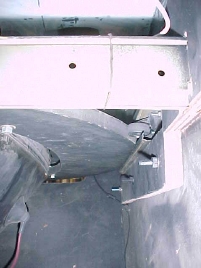
(Click for a larger view) |
|
Here's the back
of the cabinet. You can see a round disc coming out of it -- this is what
the monitor rests on. You just put your hand in the back of the cabinet
and rotate it "like a tuning knob of a very big radio." The picture
on the right is below the monitor, from the front of the opened door for
maintenance. You can see wheels that help the rotation to be smoother.
|

Lights...
Sound... Action!
On to the top of the cabinet
...
Here's the audio setup,
behind the top marquee.
The speakers were
cheap computer speakers, completely disassembled. Notice that the
PCB of the amplifier is stuck on the wood, and the audio controls can be
used from the other side. Also, Gerald used a fluorescent lamp to
illuminate the top marquee. |
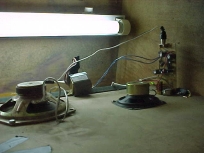
(Click for a larger view) |

On
to the wiring!
Gerald used a variety of techniques
to wire up his cabinet . . .
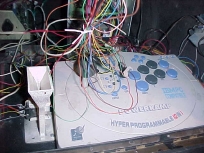
(Click for a larger view) |
For the maintenance
buttons and the second player controls, Gerald used a hacked PowerRamp.
One nice touch is that the coin slot is fully functional via the PowerRamp
as well. |
| A problem Gerald had
with his system was a bit of flakiness with the monitor. Whenever
the resolution changed, the picture went out of sync, with lots of diagonal
lines. (The monitor was a 15 year old monitor).
The workaround was
to unplug/replug the VGA cable from the PC - not terribly elegant.
Instead, Gerald made a "reset" button consisting of 5 microswitches connecting
the input wires. When you press the button it disconnects the 5 wires
of the vga input and reconnects when you release the button. |
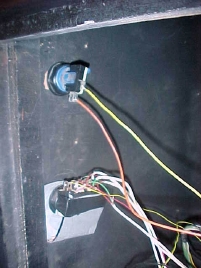
(Click for a larger view) |

(Click for a larger view) |
Spaghetti time.
This is a shot of the underside of the control panel. Notice leaf
based pushbuttons, which Gerald prefers over microswitch. |
| For the player one
controls, a simple $6 gamepad was hacked. |

(Click for a larger view) |

The
finish line!
Another interesting thing about
this cabinet is that it has two video cards, and he chooses which one is
active in the BIOS of the PC. The second video card is an ATI ProTurbo
with Mach64 chipset, and that's the one connected to the arcade monitor.
When the PC boots, there's a menu that lets you select between Windows
or MAME. This way he retains full functionality of the PC, which
is outside the cabinet (using a Voodoo 3 3000 card with regular monitor).
By the way, all the artwork for
this project was printed using Poster
software. Also, Gerald ordered
two of the $4 trackballs but never received them (from CTRsurplus) so a
bit of buyer beware is in order.
All in all a very nice project,
thanks for passing this our way! Gerald's hoping for feedback on
the project, so be sure to drop
him a line :)
--
Home --
![]()
![]()


![]()
![]()
![]()


![]()